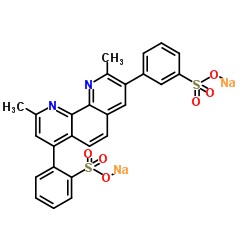Evaluation of the copper(II) reduction assay using bathocuproinedisulfonic acid disodium salt for the total antioxidant capacity assessment: the CUPRAC-BCS assay.
Carlos Campos, Rodrigo Guzmán, Encarnación López-Fernández, Angela Casado
文献索引:Anal. Biochem. 392(1) , 37-44, (2009)
全文:HTML全文
摘要
There is heightened interest in determining antioxidant status of individuals in experimental and clinical studies investigating progression of diseases or diverse aspects of oxidative stress, among others. The aim of this study was to evaluate the copper(II) reduction assay with bathocuproinedisulfonic acid disodium salt as chelating agent (the CUPRAC-BCS assay) for the total antioxidant capacity (TAC) assessment in human plasma and urine. Samples from 20 individuals were determined with four spectrophotometric assays-CUPRAC-BCS, ferric reducing ability of plasma (FRAP), trolox equivalent antioxidant capacity (TEAC), and 1,1-diphenyl-2-picrylhydrazyl assay (DPPH)-to compare these methods. CUPRAC-BCS was significantly correlated with FRAP and TEAC for plasma and urine samples (r>0.5, P<0.05 for all) and with DPPH for urine samples (r=0.925, P<0.001) but not with DPPH for plasma samples (r=0.366, P=0.112). However, the four methods do not agree given that lines of equality and regression were not matched up. The imprecision of the method is less than 6%, the detection limit is 41.8 micromol trolox equivalents/L, it is linear up to 2 mM trolox, and ethylenediaminetetraacetic acid dihydrate disodium salt (EDTA) binds to Cu(II), avoiding the formation of Cu(I)-BCS complex. This study shows that CUPRAC-BCS is a simple, fast, inexpensive, and suitable method for TAC assessment in human urine and heparinized plasma samples.
相关化合物
| 结构式 | 名称/CAS号 | 分子式 | 全部文献 |
|---|---|---|---|
 |
浴酮灵二磺酸二钠盐
CAS:52698-84-7 |
C26H18N2Na2O6S2 |
|
Leishmania amazonensis: inhibition of 3'-nucleotidase activi...
2015-08-01 [Exp. Parasitol. 131(1) , 63-8, (2012)] |
|
Ferroportin and exocytoplasmic ferroxidase activity are requ...
2013-06-14 [J. Biol. Chem. 288(24) , 17932-40, (2013)] |
|
Molecular insights into the metal selectivity of the copper(...
2009-04-21 [Biochemistry 48(15) , 3325-34, (2009)] |
|
Cu2+ is required for pyrrolidine dithiocarbamate to inhibit ...
2008-01-10 [Chem. Biol. Interact. 171(1) , 26-36, (2008)] |
|
Cu2+ and Cu+ bathocuproine disulfonate complexes promote the...
2006-07-01 [Anal. Bioanal. Chem 385(5) , 959-61, (2006)] |